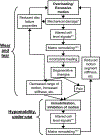Mechanical conditions that accelerate intervertebral disc degeneration: overload versus immobilization
- PMID: 15564921
- PMCID: PMC7173624
- DOI: 10.1097/01.brs.0000146049.52152.da
Mechanical conditions that accelerate intervertebral disc degeneration: overload versus immobilization
Abstract
Study design: A review of the literature on macromechanical factors that accelerate disc degeneration with particular focus on distinguishing the roles of immobilization and overloading.
Objective: This review examines evidence from the literature in the areas of biomechanics, epidemiology, animal models, and intervertebral disc physiology. The purpose is to examine: 1) what are the degeneration-related alterations in structural, material, and failure properties in the disc; and 2) evidence in the literature for causal relationships between mechanical loading and alterations in those structural and material properties that constitute disc degeneration.
Summary of background data: It is widely assumed that the mechanical environment of the intervertebral disc at least in part determines its rate of degeneration. However, there are two plausible and contrasting theories as to the mechanical conditions that promote degeneration: 1) mechanical overload; and 2) reduced motion and loading.
Results: There are a greater number of studies addressing the "wear and tear" theory than the immobilization theory. Evidence is accumulating to support the notion that there is a "safe window" of tissue mechanical conditions in which the discs remain healthy.
Conclusions: It is concluded that probably any abnormal loading conditions (including overload and immobilization) can produce tissue trauma and/or adaptive changes that may result in disc degeneration. Adverse mechanical conditions can be due to external forces, or may result from impaired neuromuscular control of the paraspinal and abdominal muscles. Future studies will need to evaluate additional unquantified interactions between biomechanics and factors such as genetics and behavioral responses to pain and disability.
Figures

References
-
- Urban JP, Roberts S. Development and degeneration of the intervertebral discs. Mol Med Today 1995;1:329–35. - PubMed
-
- Adams MA, Burton K, Bogduk N, et al. Biomechanics of Back Pain. New York, NY: Churchill Livingstone; 2002.
-
- Adams MA, Freeman BJ, Morrison HP, et al. Mechanical initiation of intervertebral disc degeneration. Spine 2000;25:1625–36. - PubMed
-
- Videman T. Connective tissue and immobilization. Key factors in musculoskeletal degeneration? Clin Orthop 1987:26–32. - PubMed
-
- Roberts S, Urban JP, Evans H, et al. Transport properties of the human cartilage endplate in relation to its composition and calcification. Spine 1996;21:415–20. - PubMed
Publication types
MeSH terms
Grants and funding
LinkOut - more resources
Full Text Sources
Medical
Research Materials

